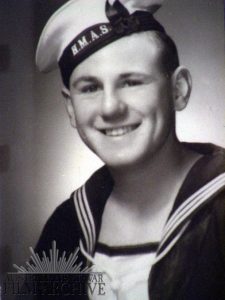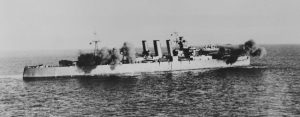- Author
- A.N. Other
- Subjects
- Biographies and personal histories, RAN operations, WWII operations, History - WW2
- Tags
-
- RAN Ships
- HMAS Shropshire
- Publication
- March 2019 edition of the Naval Historical Review (all rights reserved)
By David Mattiske
Recent announcements that the United States will partner Papua New Guinea and Australia on an initiative to further develop a naval base on Manus Island has aroused the interest of one of our stalwarts, David Mattiske. David wrote of his wartime experiences serving in HMAS Shropshire in the Admiralty Islands, which includes Manus. The following is mainly taken from his monograph Fire across the Pacific.
In the latter half of 1943 Operation CARTWHEEL was well under way. This was the planned offensive to retake Japanese occupied islands in the Southwest Pacific. On Boxing Day 1943 a massive bombardment and landing took place at Cape Gloucester in western New Britain, carried out by the recently reformed US 7th Fleet. To soften up the landing areas HMA Ships Australia and Shropshire each fired 30 broadsides, causing vast damage to Japanese installations. These were Shropshire‘s first shots fired as a cruiser of the RAN.
The plan was to bypass Rabaul and attack Kavieng, a large Japanese base in New Ireland. The Admiralties were included in this plan, the date set for 01 April 1944.
However, in early February, American forces in the central Pacific made a spectacular penetration into the Marshall Islands. This caused concern in MacArthur’s headquarters as it indicated that the much cherished MacArthur strategy of returning to the Philippines could now be given a reduced priority. MacArthur rapidly came to the conclusion that he must increase the tempo of his drive north.
With its magnificent Seeadler Harbour the Admiralties would become the springboard for the drive across the southwest Pacific and planning proceeded apace. At MacArthur’s headquarters opinion was divided about the Japanese strength and whether it was based on Manus or Los Negros. As there were some risks involved in a hastily put together plan, MacArthur assumed personal control and flew from Brisbane to Milne Bay on 27 February. In company with Vice Admiral Kincaid he boarded USS Phoenix and proceeded to the Admiralties.

The assault force, comprising the US 1st Cavalry Division of 1000 men commanded by Brigadier General William C. Chase, was transported from Sudest in destroyers which included HMAS Warramunga.On29 February, after bombardment, the force landed at Hyane Harbour, and quickly crossed to and occupied the airstrip at Momote. MacArthur went ashore and told Chase to hold his position at all costs. Late that day the Japanese recovered from their initial surprise and launched a counterattack which was beaten off.
During the next three days the destroyers Warramunga,Captain E. Dechaineux RAN, with US Ships Ammen, Mullanyand Wellesattempted to silence the Japanese batteries on the western tip of Los Negros, the islands of Hauwei and N’Drilo which were at the entrance to Seeadler Harbour. Despite the destroyers closing to 4000 yards and bombarding Japanese batteries, these batteries were still causing trouble. Rear Admiral Crutchley had advised that destroyer fire power may not be sufficient. This was sound advice as on 6 March thedestroyer USS Nicholson was hit by enemy fire and suffered considerable damage.

It was now obvious that a heavy bombardment on the islands of N’Drilo and Hauwei was required before troops could get into the harbour and land on Manus. On 29 February Shropshire sailed from Milne Bay to Sudest, joined up with US Ships Phoenix and Nashville and all sailed as Task Force 74 with Crutchley in command to a covering position north and west of the Admiralties should the Japanese attempt to send support from Truk.
HMAS Arunta had been in Sydney on leave and sailed for Sudest, arriving there to join the American destroyers which sailed with reinforcements on 3 March, each destroyer carrying 100 troops and stores. They arrived at Hyane Harbour next day and after unloading Arunta reported to Warramunga and joined in bombardment duties. Warramunga was due for a spell and with American destroyers returned to Sudest, arriving on 5 March. Captain Dechaineux recorded that ‘This operation was most interesting and had a splendid effect on the spirits of Warramunga‘s ship’s company.’
On 4 March, the same morning that Warrumunga departed, Crutchley received from Admiral Kinkaid an instruction to bombard the troublesome Japanese batteries on Hauwei. That afternoon at 1615 Shropshireopened fire at a range of 10,600 yards, closing to 9500, ceasing fire at 1624 hrs. Her fire was accurate and effective. She was followed close astern by Phoenix and Nashville.
The Hauwei bombardment saw Shropshire fire 77 x 8-inch shells and Phoenix and Nashville fired 292 x 6-inch. Five Japanese guns were put out of action enabling some landing craft to get through into Seeadler. However, Japanese artillery on Hauwei, N’Drilo Island and Pityilu Island, quickly recovered and were still active and dangerous.
After the destroyer Nicholson was hit the cruisers were again called into action on 7 March, and Shropshire fired 64 x 8-inch and 92 x 4-inch, followed by Phoenix and Nashville who fired 243 x 6-inch shells. Shropshire observers were amazed to see, even during these operations, Seabees already hard at work getting the airstrip on Los Negros ready for operations, and aircraft were landing before the fighting was completed. Traffic was now getting into Seeadler and the cruisers retired, reaching Sudest on 8 March.
On 25 March all Japanese resistance was eliminated on Los Negros as was Manus the next day, so ending a brilliant campaign in which the ships of the RAN had played an important role. Within a few weeks Seeadler Harbour became a powerful naval base, the springboard of the drive to the Philippines and an important factor in the ultimate defeat of Japan.
Manus Memories
On the lighter side most, if not all, Shropshirehands have distinct memories of Seeadler and Lorengau on Manus. Here are just a few.
Kevin Day was a well-known figure in Shropshire as captain of the Bofors on B Deck. He developed a nasty lung infection and was sent ashore to the American Hospital at Lorengau. One morning Kevin’s ward was disturbed by a party which was going from bed to bed. When they arrived at Kevin’s bed he was asked his name so they could record the presentation of a Purple Heart. This award was presented to Americans wounded or injured during active service.
Kevin explained that he was an Australian and did not think this applied to him. He was told in no uncertain terms that as a fighter helping the US in its battles he should get a Purple Heart. When Kevin retired and lived in Banora Point on the Gold Coast he became an active member of the HMAS Canberra/HMAS Shropshire Association, and he delighted in bringing out for display this prestigious and colourful award.
Surprising talents are to be found in any large group of men and Shropshire was no exception. During the dull and boring times waiting for the next operation, someone had the bright idea of forming a concert party. This party became a highly professional group and known as ‘The Capricorn Capers’.
Performances were on a stage on the bow, rigged up by shipwrights. I got the job of handling spotlights. These were several Aldis signal lamps and we covered the lens with coloured cellophane paper, from memory blue, red and yellow. I sat on top of A turret overlooking the stage. Shropshire’s band contained much talent apart from the normal chores of providing naval music. Chan Redding was a first class raconteur and comedian, later famous at a St Kilda night club.
Stepping Stones to Leyte Gulf
United States forces rapidly developed extensive facilities at Seeadler Harbour and on Manus and Los Negros islands. Lorengau, the only town on the largest island of Manus, took on the appearance of an industrial complex. This build-up was the prelude to the next step in MacArthur’s grand plan and in early October most ships had departed for Hollandia in Humboldt Bay. Here an enormous fleet had assembled for the final assault and landing in Leyte Gulf.
On 20 October 1944, American forces led by General MacArthur landed at Red Beach in the municipality of Palo, near Tacloban, Leyte.
A total of 800 ships, mainly American and Japanese, took part in this campaign which lasted from October to December 1944, but included in this number were 14 RAN commissioned ships and two Australian support ships. Among the liberation forces were 4000 Australian service personnel and 92 of them, mainly coming from RAN ships, died during the Philippines campaign.
David Mattiske has maintained a keen interest in the Philippines and with a small number of colleagues has been instrumental in the establishment of a memorial to Australian servicemen at Palo. He is now looking forward to attending the 75th anniversary celebrations commemorating the Battle of Leyte Gulf.




